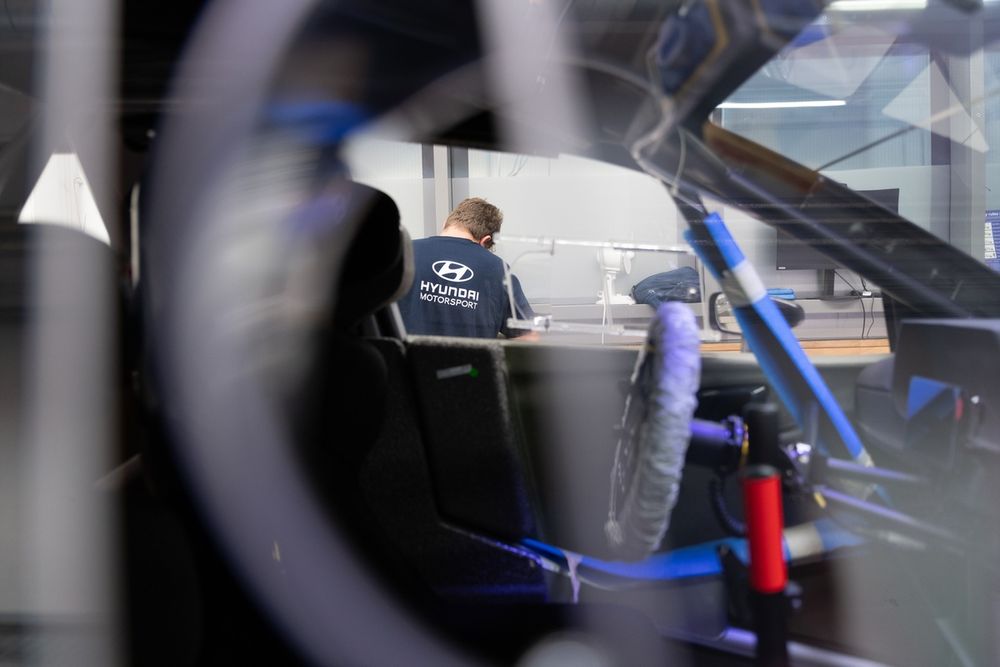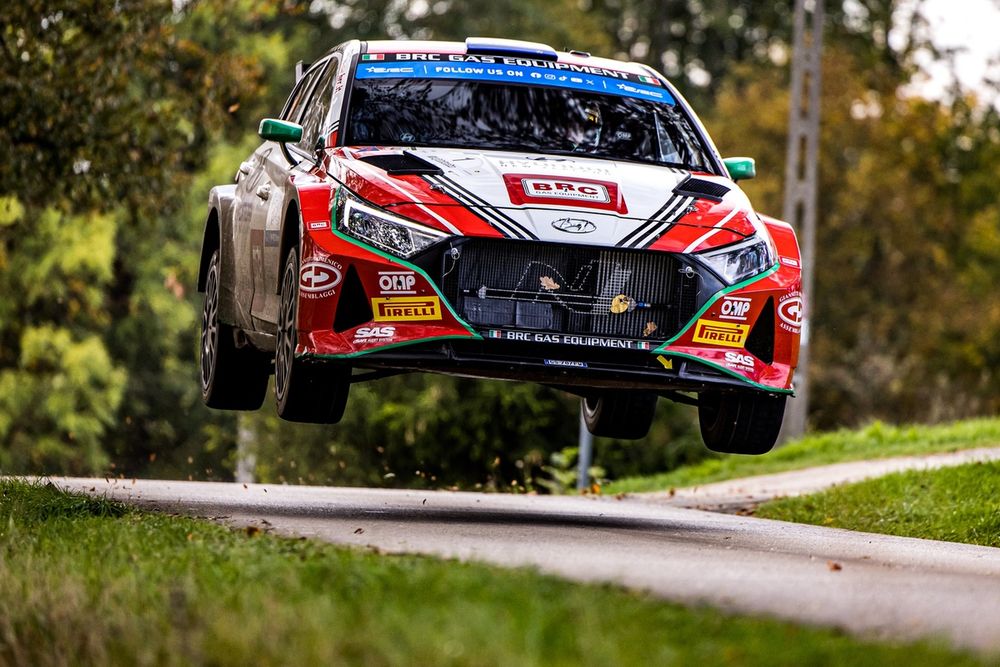
It’s quite easy to marvel at the sight of a World Rally Championship car darting through narrow asphalt lanes, sliding between snow banks and surviving some of the world’s toughest rocky terrains. But exactly how are these machines built?
Hyundai Motorsport has lifted the lid on the process with a behind-the-scenes look at how it constructs its €200,000 i20 N Rally2 car that competes in WRC2, and has won back-to-back European Rally Championship titles in the hands of Hayden Paddon.
Regardless of discipline, race and rally cars are built meticulously – it’s a fine art to assemble a life-size Meccano or Lego set, featuring approximately 3000 parts. It’s a process that Hyundai has honed to enable it to produce 30-50 cars per year from its Alzenau workshop in Germany.
“To build a Rally2 car we need around 200 hours and basically two or three mechanics work on each car, so it means we can produce a car in two weeks,” explains Hyundai customer racing manager Benoit Nogier. “In Rally1 there are many parts that have to be adjusted to its tubular chassis and they have a lot more specific parts – they don’t use any standard parts. We don’t have too many standard parts on the car, but still for them everything is designed and with the hybrid that takes a lot of time. When the hybrid is involved they cannot have as many people working on the car, so it takes a minimum of 100 hours more than a Rally2 car to build.”
Perhaps unlike any other motorsport discipline, rally cars are specifically designed to be assembled and disassembled quickly so components can be changed during timed services. This means the four-wheel-drive i20 N Rally2, based on the road-going i20 N, has to be modified. The rally car shares approximately 25% of its components with the road car, albeit some are adapted.
“The standard car is not made and designed to be assembled and de-assembled as we do with the rally cars,” points out Nogier. “For example, the light on the front of the car is designed to be re-assembled once or twice in its lifetime. For us, we need to do this process sometimes two or three times a day. We have to modify the parts for what we need it to do. If we kept the standard electrical connectors it would not work.
“It’s a big part of the design and with experience we know which parts we can use. It’s a lot of work to adapt everything, but we know what we have to do.”

Hyundai has broken down this build of an asphalt-spec i20 N Rally2 into 40 steps – a process that can be viewed in a YouTube video.
Constructing a Rally2 car begins with a bare road car chassis, which is fitted with a safety rollcage that’s then painted. This is completed before items such as the fuel tank (80 litres) and all the electrics and interior items including the dashboard, steering column, centre console and washer tank are fitted. A key part of the process involves pre-assembling components in bulk to improve efficiency. These items can then be simply fitted, which can take 15-30 minutes depending on the part.
“When we receive this bodyshell, usually we will anticipate some items from sub-assembly so the hubs for example are ready to fit onto the car, the subframes are ready, the gearbox is ready and the engine,” states Nogier.
“The engines arrive from the factory completely standard and we make the modifications, so new pistons etc” Benoit Nogier
“The first two steps is to fit the tubes for the brakes and then we put the wiring loom in. After that everything that’s required for the drivers and co-drivers inside of the car and the spare wheels are added. Then we have everything that we have pre-assembled, with the front and rear axles, the subframe and gearbox, and we finish with the front and rear bumpers.
“For example, one week we will decide to work on front axles and assemble 10-15 front axles, and the week after we would do the same with the rear axle. We try to anticipate a bit and try to have in stock several pre-assembled parts of the car to make it easier. This is a way where we can keep the same level of quality.”
Interestingly, the component Nogier says takes the most amount of time to fit to the car is the dashboard: “It’s quite a big part and you have to adjust it to the cars. The dashboards we receive from the supplier are not all exactly the same, so you have to adjust to the bodyshell and it takes a bit of time.”

The next 10 steps include continued work on the interior of the car as seats, seatbelts, steering wheel and the fire extinguisher – an FIA safety requirement – are bolted into place. Once this is completed, work moves to the exterior of the car, with the rear lights, tailgate and rear wing and front doors fitted. These body panels, minus the rear wing, are standard. Only the front and rear bumpers and wheel arches are designed specifically and are constructed from either lightweight composite fibreglass or carbon fibre.
It’s at this point where the 1.6-litre turbocharged, four-cylinder engine, which produces 285bhp, is mounted into the car, along with the five-speed sequential gearbox.
“The engines arrive from the factory completely standard and we make the modifications, so new pistons etc,” Nogier tells us. “The engine block and the cylinder is very close to the standard one. The rest is modified. The engine will then go onto the dyno to make sure the level of performance is as we want. After they deliver the engines to us we pre-assemble all the connected parts, so the starter motor, alternator, engine looms. Then we fit the clutch and the gearbox and then it is ready to go on the car.”
Once the engine has been fitted it’s time to attach the rear doors and fit the power steering pump and alternator – the latter is one of only two parts alongside the starter motor that is taken complete from the road car. The all-important pre-assembled radiator and cooling package required to tackle the intense conditions the car will face on the stages is then mounted, before front and rear subframes (another pre-assembled component), exhaust and propshaft are fitted.
“The first challenge is to organise ourselves and to find the best process to be the most efficient, but with experience it is becoming quite logical,” Nogier reckons. “I would say the biggest challenge is to keep the same level of quality because the mechanics are not always the same and because the parts are not always exactly the same, but the quality has to be the same.”
At this point the Hyundai i20 N Rally2 is really starting to take shape ahead of the final set of 10 steps.

The last pieces of this elaborate mechanical jigsaw puzzle focus largely on the exterior, beginning with the McPherson three-way adjustable front and rear dampers – one of the most worked and crucial components of any rally car. For the purposes of this exercise, the car in question is an asphalt model, but customers have the option to configure components such as suspension and brakes for competing in gravel conditions.
Uprights and then the ventilated brake discs (355mm diameter for asphalt on this model) with four-piston calipers are next on the to-do list. Leading up to a systems check, the rear anti-roll bar, front grille and bumpers, and 18-inch wheels are mounted before the vital maiden fire-up.
No matter how many cars roll off the production line, the first time a completed car fires up still brings a unique sense of satisfaction to those who construct these advanced machines, capable of tackling the harshest of conditions.
“We love this job and to see a car for the first time doing a fire-up is always a nice moment for all of us. It’s like seeing a newborn baby!” Benoit Nogier
“We love this job and to see a car for the first time doing a fire-up is always a nice moment for all of us,” smiles Nogier. “We have been working in this activity – some of us for 20 years – and each time they start the car for the first time there’s always some excitement. It’s like seeing a newborn baby!”
Transforming a shell to a rally car in two weeks is no mean feat, but could this already slick process become even more efficient in the future? “We are much more organised on the re-assembling than we were in the past,” Nogier adds. “I think in the past it was very much ‘we build a car then do another and another one’. Now we try a bit more to anticipate the production for the next six months. We have a bigger vision.
“I think now we’ve reached a certain point and I cannot see the process changing in the future. The only thing that could change is if we change technology, so if we went full EV or hybrid then you have to introduce a bit more people and process into the production of the car, but I cannot see this coming.”








